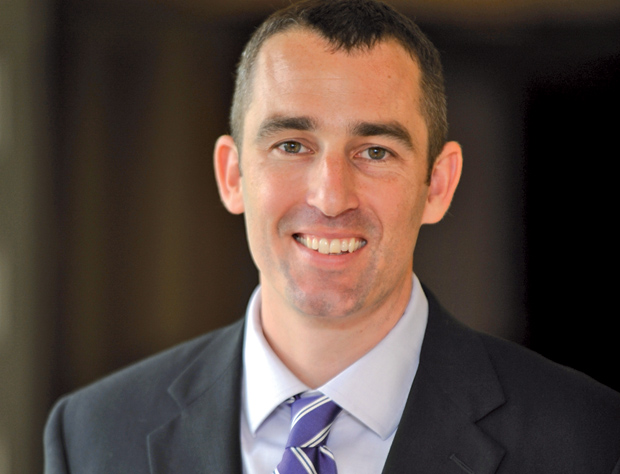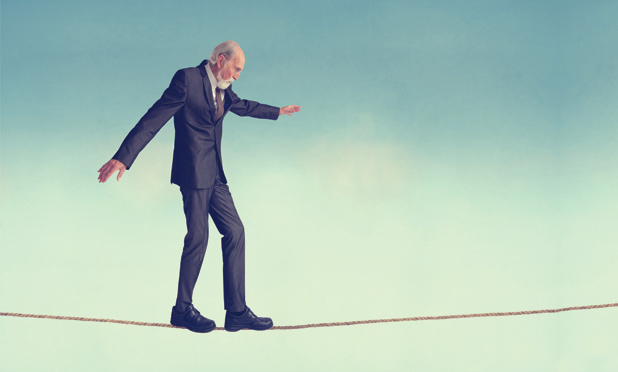It was the inaugural day of the study in 2005 when Brad Manor went out into the hot Louisiana sun to meet his first patient, a gentleman we’ll call James. Manor, now director of the Mobility and Brain Function Lab at the Harvard-affiliated Institute for Aging Research, was, at that time, a Ph.D. student at Louisiana State University (Figure 1). James, a man in his early 70s, suffered from peripheral neuropathy, a condition that caused significant nerve damage in his legs and feet. James got out of his car, carrying his cane in his hand, and walked with Manor to the lab. It wasn’t until they were standing still and talking in the exam room that James leaned on his cane with its tip on the floor to stabilize himself. Manor was surprised. “That’s opposite to what we typically think,” he remarks, looking back on the incident. “Intuitively, standing seems simpler than walking.” But James had much more difficulty standing and was actually quite competent while in motion.
The study was looking into the effects of different modes of exercise on older adults. After the initial assessment, James participated in a regular schedule of tai chi classes for about six months, and Manor followed his progress. When the term was over, James ceremoniously threw his cane into the trash. In just six months, James had become more confident in his balance, more physically active, and, surprisingly, more lucid. “This really solidified my interest in this line of research,” says Manor. “You can absolutely see people’s lives change when they start exercising regularly.” The experience directly steered him to focus his work on the complex control of balance in aging and disease, and he’s never looked back.

Thinking About Balance
For patients like James, balance can be an important issue. In general, most people are pretty well off until age 50, but after that, their bodies and minds begin to get weaker, and balance becomes a key health issue in terms of how it impacts both an individual’s health and society at large. Falls are the sixth leading cause of death among elderly people in the United States, and, although there has been progress understanding some risk factors for falls, other common risk factors such as pain, reductions in cerebral blood flow, somatosensory deficits, and foot disorders are poorly understood.
In the 1980s, a study at Yale found that one in three of all facility- living adults in senior communities fell at least once a year [1], and that number hasn’t budged since. “In the 80s and 90s, there was a lot of focus on physical-therapy-based approaches for improving balance and reducing falls that involved conventional exercise programs of strength and balance training,” says Jeff Hausdorff, director of the Center for the Study of Movement, Cognition, and Mobility at the Tel Aviv Sourasky Medical Center in Israel (Figure 2). “That certainly was helpful, but we didn’t get as far along as we would have liked to in terms of reducing the risk of falls and enhancing balance and postural control,” he adds.
That changed a bit in the late 1990s, when researchers began to realize that problems with balance were much more complex than previously thought and so therapy might have to involve more than just muscle strength. Researchers then directed their focus to the subject’s environment, particularly the home environment and things like rugs and lamp cords; this, however, didn’t have much impact, according to Hausdorff.

What wasn’t known then is that, while muscle strength and conditioning are important for balance, cognitive function may be just as important. Balance is physical and requires strong muscles and bones as well as good reflexes, but it also requires a healthy brain to coordinate all those movements. Motion and cognition, as it turns out, are deeply intertwined physiologically.
“Multitasking reduces performance in each activity, and balance is not different,” Manor explains. “We have to pay attention to the world around us, no matter if we are moving or standing.” As the capacities of body and mind begin to deteriorate with age, often so do vision, physical sensation, and cognition, each making what were once automatic balance tasks more challenging. But physical health is important for another reason: physical fitness keeps the brain running.
Mind-Body Connection
On the outskirts of Boston, Massachusetts, one building of a large network of senior living facilities called Hebrew SeniorLife houses in its basement the Institute for Aging Research’s Mobility and Brain Function Lab. The lab is a long, well-lit room with a single computer and a small assortment of equipment arranged like a very low-impact obstacle course. Against the far wall lies a long mat lined with sensors. Manor walks across it, and digital purple footsteps mimic his steps across the adjacent computer screen. For another test nearby, a patient must stand up from a chair and walk to and around a cone about ten feet away. Another mat tests a patient’s balance while standing.
When working together, Manor has patients perform each test twice—once normally and once again while performing another task, such as counting backwards by threes—to provide an assessment of the patient’s capacity for dual tasking. After following patients for months, what he’s found looks a lot like what happened with James. Even the oldest patient can improve his or her dual-task ability with certain forms of therapy.

RIGHT: Figure 3: Peter Wayne, research director for the Osher Center for Integrative Medicine, works with Brad Manor to help older people improve physical balance using a variety of exercises, including tai chi.
Tai chi seems to be particularly beneficial, mainly because a practitioner must pay attention to how the movement feels, remember what comes next, and even respond to another person’s movements. “This seems to translate well to situations involving multitasking, which is more like reality,” Manor comments. Tai chi has remained of interest to Manor since his time with James. He collaborates with Peter Wayne, research director for the Osher Center for Integrative Medicine (jointly based at the Harvard Medical School) and a long-time practitioner of tai chi (Figure 3). Using sophisticated laboratory measures of balance, they found significant reductions in fall risk after six months of tai chi [3]. Wayne suspects such exercise works for balance because it enhances the interconnection between multiple physiological processes. Tai chi not only improves physical strength and flexibility but also enhances body awareness, management of fear and anxiety, cognitive function, and multitasking, all of which contribute significantly to fall prevention.
“We have been thinking of tai chi as something coined as a gateway exercise. People are fearful of doing exercises because of falling,” Wayne notes, but as they become more comfortable in the tai chi practice, “it encourages them to do other things like walk and be more independent.”
New Technologies
For some patients, there are challenges beyond just physical conditioning and cognitive impairments. Sometimes diseases like diabetes and Parkinson’s compound a patient’s issues, making treatment more complex. Anat Mirelman and Hausdorff, colleagues at the Tel Aviv Sourasky Medical Center, use virtual reality (VR) to transport patients into simulated environments where they must respond to challenges while walking on a treadmill. Their virtual world is full of obstacles like potholes and sidewalks, fast-moving pedestrians, and uneven pavement— things patients must avoid or step over.
“We wanted to create an environment that introduces cognitive challenges, but we wanted these challenges to be ecologically valid,” says Mirelman. “VR enables us to do that while adjusting the difficulty levels of the tasks based on a person’s ability.” The system is adaptive, and the training is progressive in nature, meaning that as participants’ skill levels increase, so does the difficulty. Manor and Mirelman’s study involved 302 older adults with mild cognitive impairments and others with Parkinson’s disease, all with a history of at least two falls in the six months prior to the study. After the intervention, it appeared that patients with Parkinson’s disease showed the most improvements. “Patients with Parkinson’s rely more on cognitive function while walking, because of their motor impairments,” Mirelman explains. “The VR environment implicitly teaches strategies of movement that change performance and functional ability.”
Parkinson’s and stroke patients seem to benefit from a bit of a jump-start known as noninvasive brain stimulation. Two types have been tested so far: transcranial magnetic stimulation and transcranial direct current stimulation (tDCS). Both therapies essentially do the same thing by activating target areas in the brain with electrical currents. Neurophysiological research has shown both therapies to be safe and effective in improving mental function.
Manor is now trying to identify additional targets in the brain, particularly in the prefrontal cortex, the small area of the brain that plays a specific role in cognitive processes like attentional control, working memory, problem solving, and planning. Stimulating this area of the brain increases a patient’s ability to multitask. He just completed a pilot trial involving 20 individuals over age 65 with physical and cognitive impairments but no other major diseases. After a two-week treatment period in which patients received ten 20-minute sessions of tDCS, those receiving the real intervention (as compared to a placebo) exhibited significant improvement in their ability to multitask while standing and walking [4] for at least a month following the treatments.
Brain Rx and Smart Technology
The fact that everyone ages differently also introduces complexity in treating individuals. In reality, no two falls are the same. They are challenging to study because they can happen for a variety of reasons. Very healthy people may fall while gardening or because they were exercising outdoors and someone bumped into them; a less healthy person may fall indoors while dressing or when getting out of bed during the night. “Both are falls” according to Manor, “but the latter is the type of person and fall for which our research tends to focus.”
Alvaro Pascual-Leone, the associate dean for Clinical and Translational Research at the Harvard Medical School, began a program called the Brain Fit Club, which Manor is a part of and uses in his lab at SeniorLife. Members of the club start with a comprehensive neuropsychological exam, which the evaluator then uses to develop an individualized plan based on the resulting brain health profile. This so-called brain prescription makes recommendations for maintaining a healthy brain and may include a combination of scientifically validated computerized cognitive training, brain stimulation, nutritional coaching, mindfulness training, sleep and lifestyle education, gait and balance evaluation and treatment, and group classes in meditation, tai chi, and gentle yoga. Patients in the program are continually monitored, with the prescription being adjusted should any changes occur. And it’s worked.
“Part of the question is how do we deliver solutions to large numbers of people,” says Hausdorff. Although the technology is relatively inexpensive, it requires a change of thinking and appropriate allocation of space and resources to make these types of solutions widely available in senior centers and rehab facilities. Smartphone technology, he suggests, might be a complementary alternative. It has been used for those with Parkinson’s to analyze a patient’s walking ability and postural control, while also providing real-time feedback [5]. “A dedicated app, combined with dedicated sensors, can act as if a physical therapist or rehab specialist walks with you at all times, providing appropriate feedback and instructions to enhance balance and gait,” Hausdorff explains.
Manor is excited about the idea as well but thinks that smart home devices might also play a role. “There’s a whole new world of automated technology that may be used in people’s homes to keep them safe or to assess different outcomes,” he says. A change in frequency in using the restroom, for example, is very predictive of the onset of certain diseases; so Minor suggests that a smart home device might send an alert to a family member immediately, rather than waiting for the person to get sick enough to go to the doctor. “If we can get these technologies out to the clinicians and therapists in many settings, such as hospitals, nursing homes, and senior housing,” Hausdorff notes, “then maybe we can actually reduce the frequency of falls among older adults on a large scale and impact that one out of three number that’s been around for a while.”
References
- M. E. Tinetti, M. Speechley, and S. F. Ginter, “Risk factors for falls among elderly persons living in the community,” New Eng. J. Med., vol. 319, no. 26, pp. 1701–1707, 1988. doi: 10.1056/nejm198812293192604.
- S. G. Leveille, D. P. Kiel, R. N. Jones, A. Roman, M. T. Hannan, F. A. Sorond, H. G. Kang, E. J. Samelson, M. Gagnon, M. Freeman, and L. A. Lipsitz, “The MOBILIZE Boston study: Design and methods of a prospective cohort study of novel risk factors for falls in an older population,” BMC Geriatr., vol. 8, no. 1, 2008. doi: 10.1186/1471-2318-8-16.
- F. Li, P. Harmer, K. J. Fisher, E. McAuley, N. Chaumeton, E. Eckstrom, and N. L. Wilson, “Tai chi and fall reductions in older adults: A randomized controlled trial,” J. Gerontol. A Biol. Sci. Med. Sci., vol. 60, no. 2, pp. 187–194, 2005. doi: 10.1093/gerona/60.2.187.
- D. Zhou, J. Zhou, H. Chen, B. Manor, J. Lin, and J. Zhang, “Effects of transcranial direct current stimulation (tDCS) on multiscale complexity of dual-task postural control in older adults,” Exp. Brain Res., vol. 233, no. 8, pp. 2401–2409, 2015. doi: 10.1007/ s00221-015-4310-0.
- A. C. Barros, J. Cevada, À. Bayés, S. Alcaine, and B. Mestre, “User-centred design of a mobile self-management solution for Parkinson’s disease,” in Proc. 12th Int. Conf. Mobile and Ubiquitous Multimedia (MUM ‘13), 2013. doi: 10.1145/2541831.2541839.



